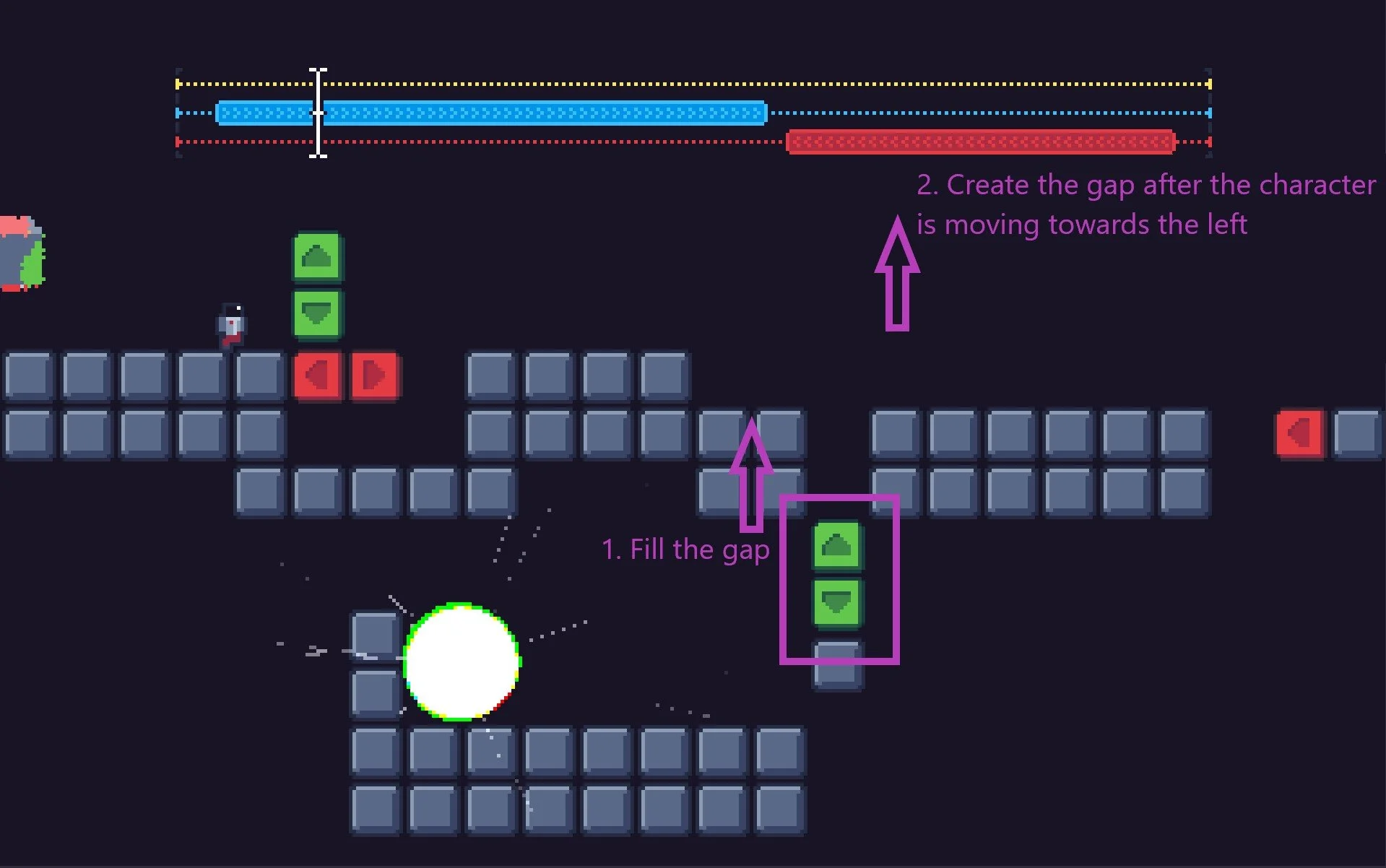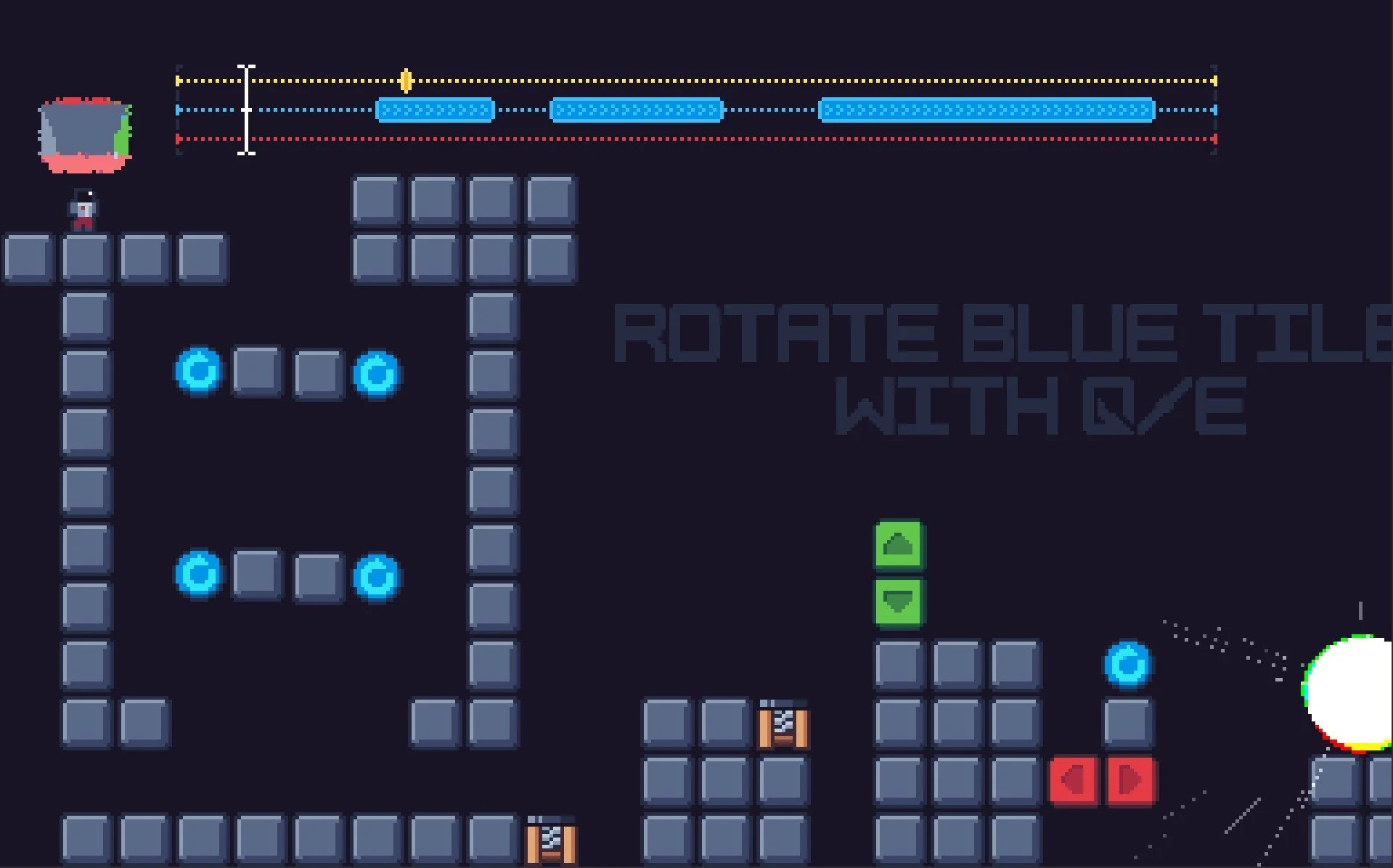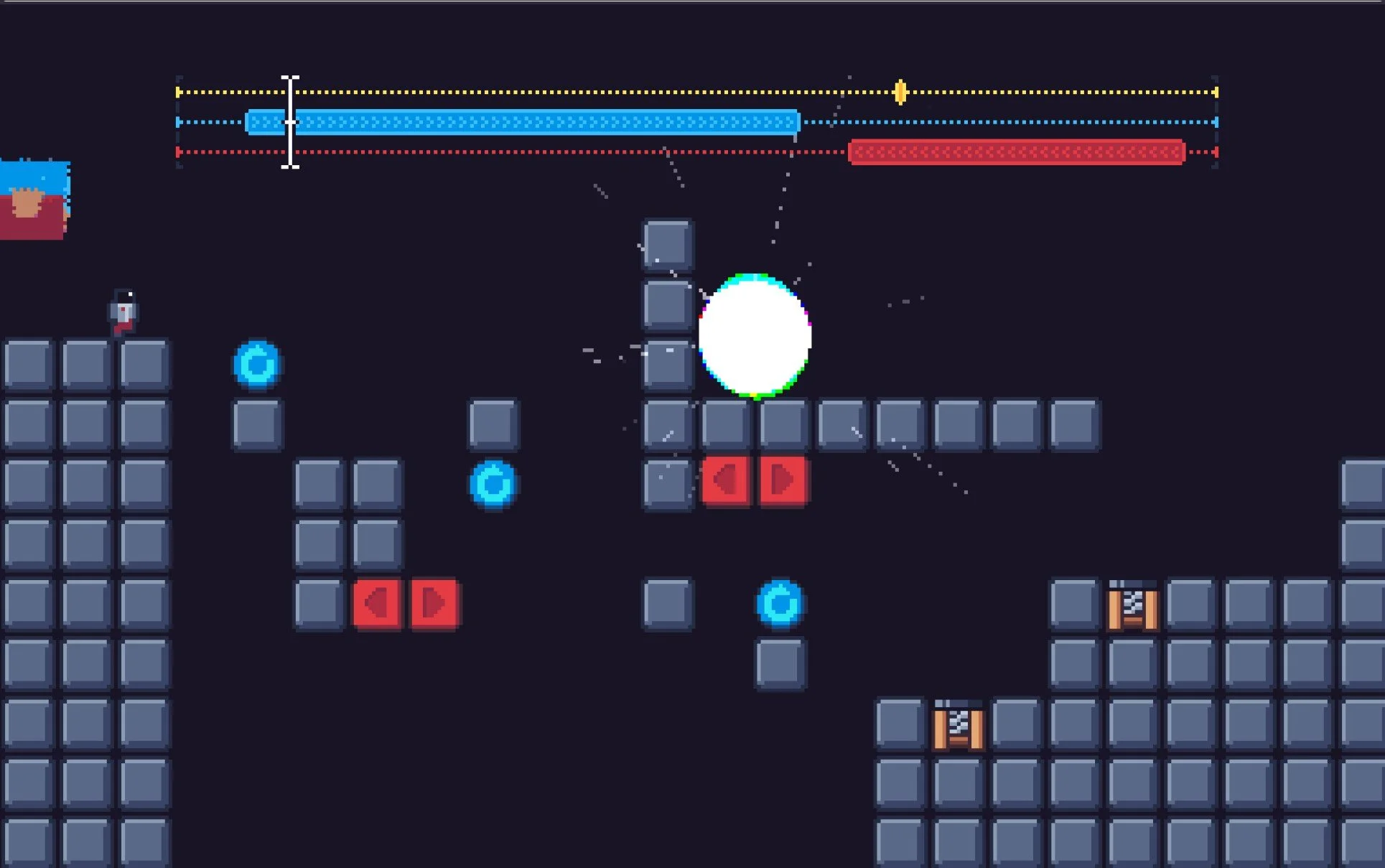PROCESS DEEP-DIVE: Billy Bob's Block Bonanza
This page is dedicated to demonstrating my approach to:
Designing all the interesting and detailed Levels
Level Designs
In my role as the level designer for this game jam project, my central task involves the creation of captivating levels within a short time. The inherent challenges arise from both the scarcity of time and the absence of playtest feedback, making it more demanding to develop levels that seamlessly align with the game mechanics and provide an enjoyable gameplay experience.
My previous experience in designing levels for the 2D puzzle platformer Lemon's Journey has been instrumental. Adhering to the guiding principle of "Introduce, Approach, Challenge," I ensured a cohesive difficulty progression and learning curve. Translating this knowledge to the current project, I not only maintained this disciplined approach but also incorporated an additional step before commencing level design. This extra phase involves a comprehensive analysis of the game mechanics, delving into their intricacies to uncover potential encounters that can be seamlessly integrated into the levels.
Analyze Game Mechanics
The game's objective is straightforward: players control the platforms, not the character, to assist it in reaching its destination. Two primary elements define the gameplay – the timeline system, which outlines the character's action sequence, and various controllable platforms.
The Timeline System consists of four components represented by three lines, each denoting a distinct action type. Yellow dots signify "JUMP," blue areas indicate "Moving Right," and red areas represent "Moving Left." The prominent white "I" shape scanner serves as the timeline indicator; wherever it overlays, the character performs corresponding actions.
This system empowers players to anticipate the character's actions and strategically position platforms based on the evolving situation. However, given the intricate nature of the game, accurately predicting the character's complete trial solely through map and timeline analysis proves challenging. Due to the game's complexity, players can typically foresee only a few seconds ahead and must react promptly.
This dynamic results in a crucial conclusion: the game's unique mechanic sometimes transforms it more into a reflex-based experience, demanding swift thinking and rapid reactions. While this complexity may challenge players' ability to operate under time pressure, it also enhances the game's appeal within the puzzle genre. The intricate timing requirements contribute to a more exhilarating gameplay experience, with successfully navigating these challenges providing a heightened sense of satisfaction.
The other main mechanics are the platforms:
One-direction Movable Platforms:
These versatile platforms can move either horizontally or vertically, offering a myriad of possibilities for level design. The beauty of this mechanic lies in its adaptability; in different scenarios, the same platform can be manipulated multiple times, each serving distinct purposes within a single level. For example, these platforms can bridge gaps or create them. Similarly, utilizing them to obstruct the character's progress can be interpreted as an obstacle or a strategic element aiding level progression. This inherent duality is a key experiential element I aim to convey through level design, showcasing how a single platform can dynamically influence gameplay outcomes.
Jump Pad Platforms:
This specialized platform propels the character into the air upon activation. Although it has the intricacy of varying landing distances based on the character's position at activation, I've opted to reduce the impact of this mechanic in the current game version. The goal is to eliminate unnecessary challenges or frustrations for players, prioritizing a smoother and more accessible gaming experience.
Rotation Platforms:
True to their name, these platforms can be rotated either clockwise or counterclockwise. The rotation comes with an animated time, adding a strategic layer as the chosen rotation direction significantly impacts gameplay. This feature prompts players to consider the timing and direction of rotation, introducing an engaging element that contributes to the overall complexity and depth of the game.
Level Design Breakdown
LEVEL 0:
As the first level of the game, its primary purpose is to acquaint players with the game's objectives and facilitate their understanding of the timeline system.
Introduce: How the timeline system (yellow, blue and red blocks) intricately connects with the character's actions.
Approach: N/A
Challenge: N/A
Postmortem: The initial concept of introducing the timeline system encounters a minor setback due to the presence of clickable but inconsequential platforms. While the initial idea was to allow players to familiarize themselves with the controls without the risk of failing the level, the additional elements inadvertently divert attention and create confusion regarding their purpose. The key takeaway from this level is the importance of introducing one concept at a time, particularly at the beginning of the game. This insight underscores the need for a focused and sequential introduction to enhance player comprehension and engagement.
LEVEL 1:
This level is designed with simplicity and clarity in mind. Players are tasked with manipulating vertical platforms to bridge gaps on the floor, enabling the character to reach its destination.
Introduce: The primary objective is to familiarize players with using platforms to fill gaps. The level and timeline are intentionally basic, resulting in a highly predictable character behavior that reduces the overall difficulty. The placement of platforms at different heights serves as a cue, signaling to players that there is an "animation time difference" associated with moving the platforms. Notably, the fact that character/timeline keeps progressing while the players are controlling the platforms emphasizes the importance of sequencing. But this level is very forgiving and doesn't heavily penalize suboptimal sequencing, it lays the foundation for understanding the significance of order in subsequent challenges.
Approach: N/A
Challenge: N/A
LEVEL 2:
In this level, players are tasked to utilize platforms to extend the edge of the floor, allowing the character to reach more distant locations.
Introduce: The focus here is on demonstrating the typical applications of horizontal platforms in extending the floor. Simultaneously, players become aware that platforms can obstruct each other. For instance, to move a horizontal platform at this level, players must first clear the path by adjusting the position of vertical platforms.
Approach: Following the extension of the floor by attaching a horizontal platform to the edge, players are prompted to swiftly fill the gaps below using vertical platforms. This approach prevents the character from falling like the last level and adds a layer of time-sensitive decision-making to the level.
Challenge: N/A
LEVEL 3:
This level's central challenge revolves around utilizing a single vertical platform in two distinct phases. Initially, players employ the platform conventionally to fill a gap, enabling the character's progression. However, the twist comes when they must subsequently remove the same platform to recreate the gap, allowing the character to descend.
Introduce: Departing from the conventional approach of consistently filling gaps, this level introduces the concept that sometimes creating gaps is essential for progression. It prompts players to adopt a flexible thinking pattern wherein a single platform can serve multiple purposes based on the evolving situation.
Approach: The overall pace of the level is faster than previous ones, demanding swift actions from players as they navigate through filling gaps and extending edges, akin to previous challenges.
Challenge: The key challenge lies in the reversal of thinking – the need to transition from filling the gaps to intentionally recreating gaps. This shift in mindset adds a layer of complexity to the level.
LEVEL 4:
Building upon the familiar elements, this level introduces a new gameplay element: springboards.
Introduce: The primary focus of this level is to acquaint players with the mechanics and functionality of springboards.
Approach: Leveraging the experience gained from the previous level, players are challenged to employ their newfound knowledge to manipulate the green vertical platform effectively. In a reversal of the previous scenario, they must first move the platform away to create a gap, allowing the character to progress. Subsequently, they must strategically place it back to obstruct the character from falling.
Challenge: Reversal of thinking.
LEVEL 5:
Designed to offer an exhilarating and fast-paced gameplay experience, this level challenges players to swiftly discern the purpose of each platform and determine the optimal sequence of manipulation.
Introduce: N/A.
Approach: Players are tasked with rapidly recognizing the traditional uses of each platform and executing these actions in a well-ordered sequence to overcome the level's challenges.
Challenge: The primary challenge in this level revolves around cognitive dexterity. Players must simultaneously manipulate the current situation while strategizing and planning their next moves. In essence, this level tests their multitasking skills as they navigate through the complexities of the gameplay.
LEVEL 6:
Level 6 offers players an enjoyable experience with the rotation platform. The primary objective is to use these platforms to create openings that enable the character to descend gracefully.
Introduce: This level serves as an introduction to the rotation platform mechanic, acquainting players with its functionality.
Approach: Initially, players must swiftly rotate all the platforms to facilitate the character's descent. As the level progresses, they are tasked with executing a series of precise manipulations on various platforms in rapid succession, forming a fast-paced and engaging experience.
Challenge: Level 6 focuses on familiarizing players with the new rotation platform mechanic, and as such, the challenges presented are not overly complex.
LEVEL 7:
Serving as the culminating level in this compact game jam creation, Level 7 harmoniously merges all previously introduced elements, delivering a high-octane and demanding experience.
Introduce: N/A.
Approach: Players must navigate the level with speed, strategy, and precision, deftly manipulating all available platforms to progress.
Challenge: This level presents players with the dual challenge of rapid reaction and precise execution. As the level reaches its conclusion, a unique mental challenge emerges: players must exhibit patience while their hands and minds were racing to fulfill multiple tasks simultaneously. The precision required to activate the springboard and safely land the character underscores the demanding nature of this final challenge.








